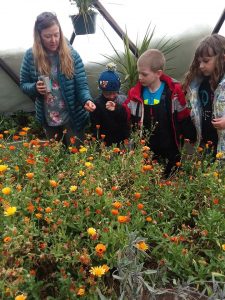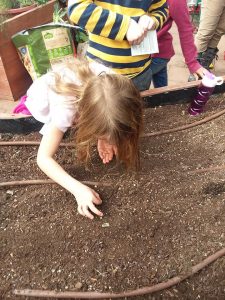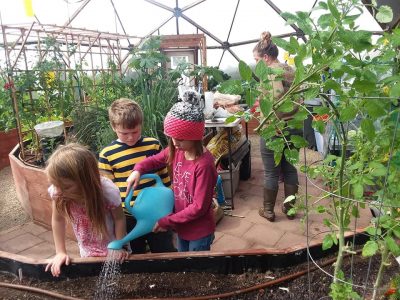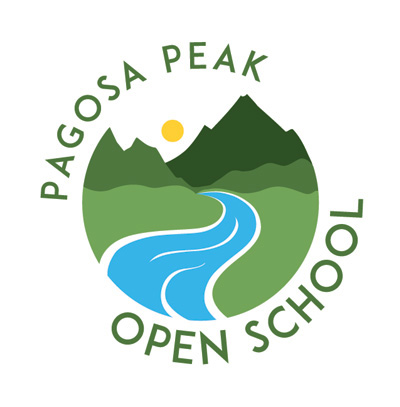 In downtown Pagosa Springs, situated near the San Juan River and world-famous hot springs, three impressive and large dome structures sit next to the quaint river walk. One dome in particular supports education. Inside of this dome, a wide array of plants grow year-round, thanks to the care of the Geothermal Greenhouse Partnership (GGP). The appropriately named “Education Dome” is where Kelle Bruno’s 1st and 2nd grade class spent the chilly winter months planting, harvesting and learning.
In downtown Pagosa Springs, situated near the San Juan River and world-famous hot springs, three impressive and large dome structures sit next to the quaint river walk. One dome in particular supports education. Inside of this dome, a wide array of plants grow year-round, thanks to the care of the Geothermal Greenhouse Partnership (GGP). The appropriately named “Education Dome” is where Kelle Bruno’s 1st and 2nd grade class spent the chilly winter months planting, harvesting and learning.
High altitude gardening can be a difficult obstacle to those above 5,000ft at any age, but Pagosa Peak Open School (PPOS) students have overcome the elements here in Pagosa Springs to grow plants year-round. Due to a unique opportunity with the GGP, PPOS students can get their hands in the dirt and experience the life cycle of a variety of plants even when the ground is covered in several feet of snow.
Pagosa Springs is surrounded by national forest, several national parks, bike trails, and a wide range of environmental micro-climates including alpine environments, montane forests, sage flats, and high desert. According to the USDA Plant Hardiness Zone Map, Pagosa Springs falls zone 5a. These zones help gardeners ascertain which plants will thrive in any given location. In zone 5a, for example, beans, brussels sprouts, cabbage, cauliflower, corn, cucumber, onions, peppers, squash and tomatoes are some of the more hardy plants during the peak growing months.
It’s no secret that the growing season in Pagosa Springs is short. Our average last frost date is May 15th and the average first frost date falls on October 15th. How does a year-round school with a pivotal gardening education program teach in such a climate? The answer lies beyond zone appropriate planting and in innovative high altitude greenhouse structures like the GGP domes.
 “As far as growing lessons, they all know that plants need soil, water, nutrients, light, and space to thrive,” says Ms. Bruno. “My class can tell you all of the parts of a plant and what a seed is. They enjoy walking into the hot, humid space in the middle of winter.
“As far as growing lessons, they all know that plants need soil, water, nutrients, light, and space to thrive,” says Ms. Bruno. “My class can tell you all of the parts of a plant and what a seed is. They enjoy walking into the hot, humid space in the middle of winter.
“They get really into the changes of the plants from week to week and they also like taking produce back to school and preparing it into a salad or a morning snack for the rest of the class.
“I had an especially memorable day with a group last year where we did a sensory lesson. The kids were asked to use their 5 senses and then write about their experience. One student wrote, ‘This broccoli tastes like victory!’”
One PPOS 1st grader, Lotus, whose favorite vegetable is a tomato, excitedly tells of how she has “fun putting hands in the dirt” and “planting plants and seeing worms”. This is Lotus’s first experience working in the garden and she thinks the GGP domes “look like giant igloos.”
As the season rapidly turns to spring Ms. Bruno’s students will move their gardening to Ms. Bruno’s Colorado Proud Certified farm, Southern Roots.
“We are really fortunate to be able to use the (GGP) space as a greenhouse to start our plants for the summer. We will likely plant tomatoes, peppers, annual flowers, herbs, broccoli, and cabbages to be grown at school in our small garden as well as at our 1/8-acre property at my house.”
Southern Roots is where PPOS students will take their gardening to the land and produce crops for a special CSA (Community Supported Agriculture) project available to PPOS families. On April 25th, during the Spring Student Showcase, 10 families won a free, eight-week CSA provided by Southern Roots. The CSA will run July 8th-August 30th, providing these families with fresh, local veggies during these two summer months.
No matter the challenges of our climate or altitude, PPOS maintains a Place-based education model that encourages gardening and outdoor learning. PPOS believes that outdoor education provides meaningful contextual experiences in both natural and constructed environments. This education can occur both inside and outside the classroom, both inside a grow dome structure and outside on a farm. For PPOS students learning will take place beyond the four walls of the classroom.
**Photos by Kelle Bruno, Keith Bruno and Alison Beach.

